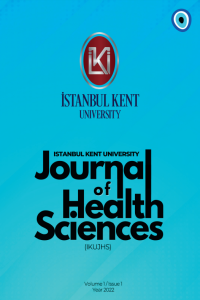Parkinson Hastalarında Sensör Temelli Yürüme Analizi
Yürüyüş bozukluğu Parkinson hastalığının (PH) temel semptomlarından biridir. Bu çalışmanın amacı PH hastalarında atalet sensörleri kullanarak yürüme parametrelerini, hastalık şiddeti ile yürüme parametreleri arasındaki ilişkiyi araştırmaktır. Parkinson hastalığı tanısı almış onsekiz hastaya iki dakika yürüme testi yapıldı. Yürüme parametreleri incelendi ve yürüme parametrelerinin MDS-UPDRS Bölüm III ve Hoehn &Yahr (H&Y) ölçeği puanları ile ilişkisi araştırıldı. Çalışmaya yaş ortalaması 65.78 ± 8.07 olan 18 PH tanılı hasta (sekiz kadın, on erkek) dahil edildi. Ayak vuruş açısı (r=-0,66), dönüş açısı (r=-0,73), adım uzunluğu (r=-0,52) ve dönüş hızı (r=-0,54) MDS-UPDRS bölüm III skoru ile negatif, dönüş süresi (r=0,58) ile pozitif korelasyon, gösterdi (p<0,05). H&Y evrelemesi, ayak vuruş açısı (r=-0.58), parmak uç açısı (r=-0.53) ile negatif, dönüş süresi (r=0.56) ve dönüş hızı (r=-0.52) ile pozitif korelasyon gösterdi.Atalet sensörleri ile Parkinson hastalarının klinik değerlendirmesini destekleyen objektif yürüyüş parametreleri sağlanabilir.
Anahtar Kelimeler:
Parkinson hastalığı, Yürüme analizi, Atalet sensörleri, APDM
Sensor-Based Gait Analysis in Patients with Parkinson Disease
Gait impairment is one of the cardinal signs of Parkinson disease (PD). This study aims to investigate gait parameters using inertial sensors and evaluate the relation between disease severity and gait parameters. Two-minute walkway tests were performed on eighteen patients with PD. Gait parameters were analyzed and the relation between gait parameters and the scores of MDS-UPDRS Part III and the Hoehn &Yahr (H&Y) scale is investigated. Eighteen PD patients (eight female, ten male) with a mean age of 65.78 ± 8.07 were included in the study. Foot strike angle(r=-0.66), turn angle (r=-0.73), stride length (r=-0.52), and turn velocity (r=-0.54) showed negative, turn duration (r=0.58) showed a positive correlation with the score of MDS-UPDRS part III, (p<0.05). H&Y staging showed a negative correlation with foot strike angle (r=-0.58), toe off angle (r=-0.53), and turn velocity (r=-0.52), a positive correlation with turn duration (r=0.56). Inertial sensors may provide objective gait parameters supporting the clinical assessment of patients with PD.
Keywords:
Parkisnon disease, Gait analysis, Inertial sensors, APDM,
___
- Agostini, V., Lanotte, M., Carlone, M., Campagnoli, M., Azzolin, I., Scarafia, R., Massazza, G., Knaflitz, M., 2015. Instrumented gait analysis for an objective pre-/postassessment of tap test in normal pressure hydrocephalus. Arch. Phys. Med. Rehabil. 96, 1235–1241. https://doi.org/10.1016/j.apmr.2015.02.014
- Fang, X., Liu, C., Jiang, Z., 2018. Reference values of gait using APDM movement monitoring inertial sensor system. R. Soc. Open Sci. 5, 170818. https://doi.org/10.1098/rsos.170818
- Goetz, C.G., Stebbins, G.T., Wolff, D., DeLeeuw, W., Bronte-Stewart, H., Elble, R., Hallett, M., Nutt, J., Ramig, L., Sanger, T., Wu, A.D., Kraus, P.H., Blasucci, L.M., Shamim, E.A., Sethi, K.D., Spielman, J., Kubota, K., Grove, A.S., Dishman, E., Taylor, C.B., 2009. Testing objective measures of motor impairment in early Parkinson’s disease: Feasibility study of an at-home testing device. Mov. Disord. Off. J. Mov. Disord. Soc. 24, 551–556. https://doi.org/10.1002/mds.22379
- Goetz, C.G., Tilley, B.C., Shaftman, S.R., Stebbins, G.T., Fahn, S., Martinez-Martin, P., Poewe, W., Sampaio, C., Stern, M.B., Dodel, R., Dubois, B., Holloway, R., Jankovic, J., Kulisevsky, J., Lang, A.E., Lees, A., Leurgans, S., LeWitt, P.A., Nyenhuis, D., Olanow, C.W., Rascol, O., Schrag, A., Teresi, J.A., van Hilten, J.J., LaPelle, N., Movement Disorder Society UPDRS Revision Task Force, 2008. Movement Disorder Society-sponsored revision of the Unified Parkinson’s Disease Rating Scale (MDS-UPDRS): scale presentation and clinimetric testing results. Mov. Disord. Off. J. Mov. Disord. Soc. 23, 2129–2170. https://doi.org/10.1002/mds.22340
- Hausdorff, J.M., Cudkowicz, M.E., Firtion, R., Wei, J.Y., Goldberger, A.L., 1998. Gait variability and basal ganglia disorders: stride-to-stride variations of gait cycle timing in Parkinson’s disease and Huntington’s disease. Mov. Disord. Off. J. Mov. Disord. Soc. 13, 428–437. https://doi.org/10.1002/mds.870130310
- Lai, Y.-R., Lien, C.-Y., Huang, C.-C., Lin, W.-C., Chen, Y.-S., Yu, C.-C., Cheng, B.-C., Kung, C.-T., Kung, C.-F., Chiang, Y.-F., Hung, Y.-T., Chang, H.-W., Lu, C.-H., 2022. Clinical Disease Severity Mediates the Relationship between Stride Length and Speed and the Risk of Falling in Parkinson’s Disease. J. Pers. Med. 12, 192. https://doi.org/10.3390/jpm12020192
- Mancini, M., Horak, F.B., 2016. Potential of APDM mobility lab for the monitoring of the progression of Parkinson’s disease. Expert Rev. Med. Devices 13, 455–462. https://doi.org/10.1586/17434440.2016.1153421
- Merola, A., Sturchio, A., Hacker, S., Serna, S., Vizcarra, J.A., Marsili, L., Fasano, A., Espay, A.J., 2018. Technology-based assessment of motor and nonmotor phenomena in Parkinson disease. Expert Rev. Neurother. 18, 825–845. https://doi.org/10.1080/14737175.2018.1530593
- Muro-de-la-Herran, A., Garcia-Zapirain, B., Mendez-Zorrilla, A., 2014. Gait analysis methods: an overview of wearable and non-wearable systems, highlighting clinical applications. Sensors 14, 3362–3394. https://doi.org/10.3390/s140203362
- Na, B.S., Ha, J., Park, J.-H., Ahn, J.H., Kim, M., Kim, J.S., Kim, H.-T., Cho, J.W., Youn, J., 2019. Comparison of gait parameters between drug-naïve patients diagnosed with multiple system atrophy with predominant parkinsonism and Parkinson’s disease. Parkinsonism Relat. Disord. 60, 87–91. https://doi.org/10.1016/j.parkreldis.2018.09.018
- Poewe, W., Seppi, K., Tanner, C.M., Halliday, G.M., Brundin, P., Volkmann, J., Schrag, A.-E., Lang, A.E., 2017. Parkinson disease. Nat. Rev. Dis. Primer 3, 17013. https://doi.org/10.1038/nrdp.2017.13
- Raccagni, C., Gaßner, H., Eschlboeck, S., Boesch, S., Krismer, F., Seppi, K., Poewe, W., Eskofier, B.M., Winkler, J., Wenning, G., Klucken, J., 2018. Sensor-based gait analysis in atypical parkinsonian disorders. Brain Behav. 8, e00977. https://doi.org/10.1002/brb3.977
- Başlangıç: 2022
- Yayıncı: İstanbul Kent Üniversitesi
Sayıdaki Diğer Makaleler
YASAL DÜZENLEMELER ÇERÇEVESİNDE HEMŞİRELERİN MESLEKİ ROLLERİ VE ÖZERKLİK
Primary Lung Malign Mesenchymal Tumors
Murat KAVAS, Cansel ATİNKAYA BAYTEMİR, Ayşe ERSEV, Akın ÖZTÜRK, Onur DERDİYOK, Selma AYDOĞAN EROĞLU, Sümeyye ALPARSLAN BEKİR, İrfan YALÇINKAYA
Parkinson Hastalarında Sensör Temelli Yürüme Analizi
Özgür ÖZTOP-ÇAKMAK, Kardelen AKAR, Hussein YOUSSEF, Atay VURAL
Bebekler İçin Yüzdürme Aktivitesi : Gözlemsel Bir Çalışma
Özge Eda KARADAĞ, Merve AZAK, Duygu GÖZEN
TARİHİ GEÇMİŞ KOMPOZİT REZİNLERİ KULLANMAK MÜMKÜN MÜ? : FTIR ANALİZİ
Seda ÖZMEN, Bengü DOĞU, Ayşe Aslı ŞENOL, Bora KORKUT, Bilge TARÇIN, Pınar YILMAZ ATALI
